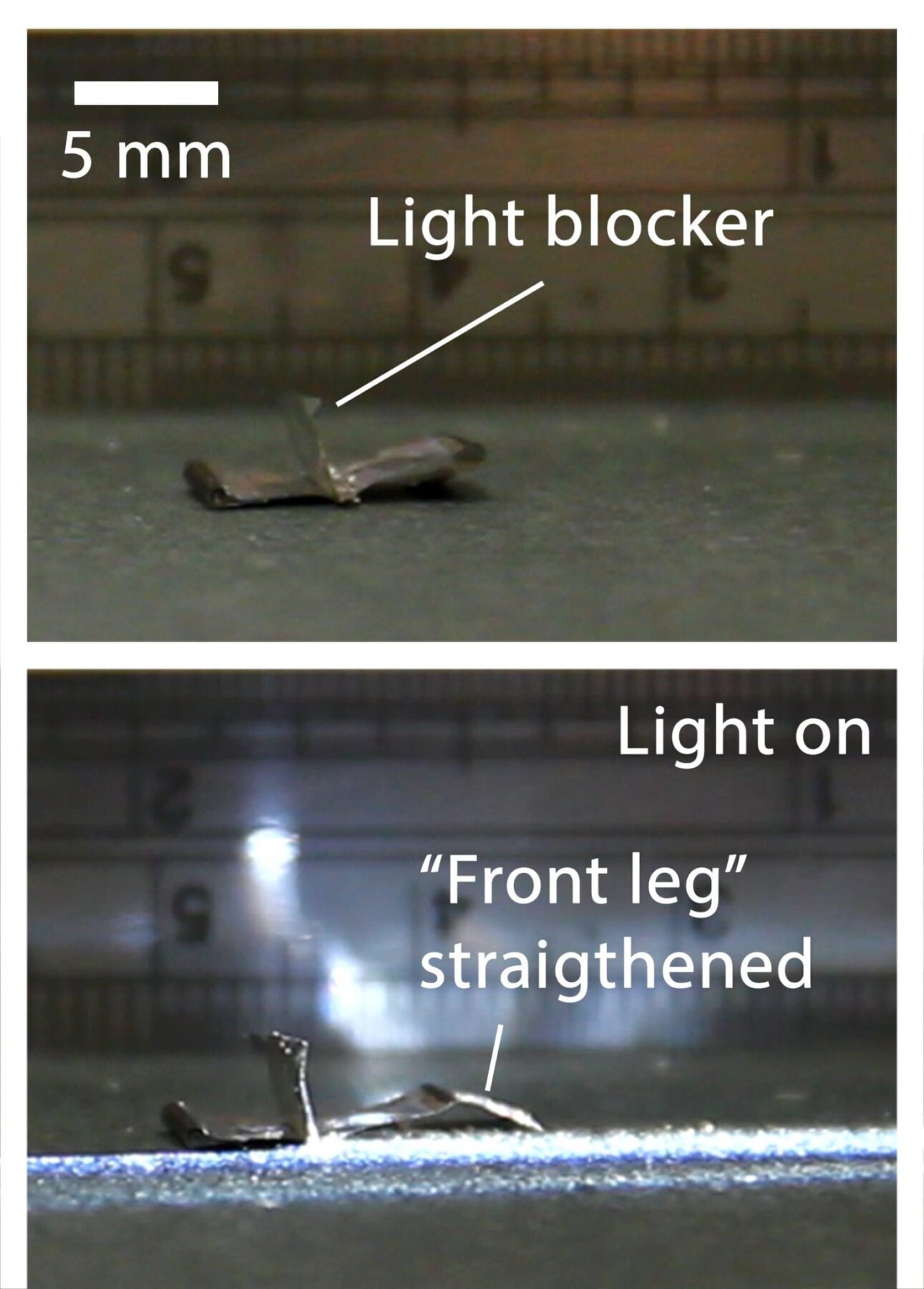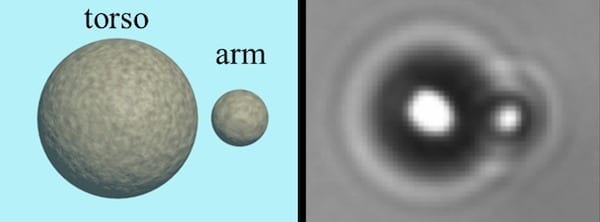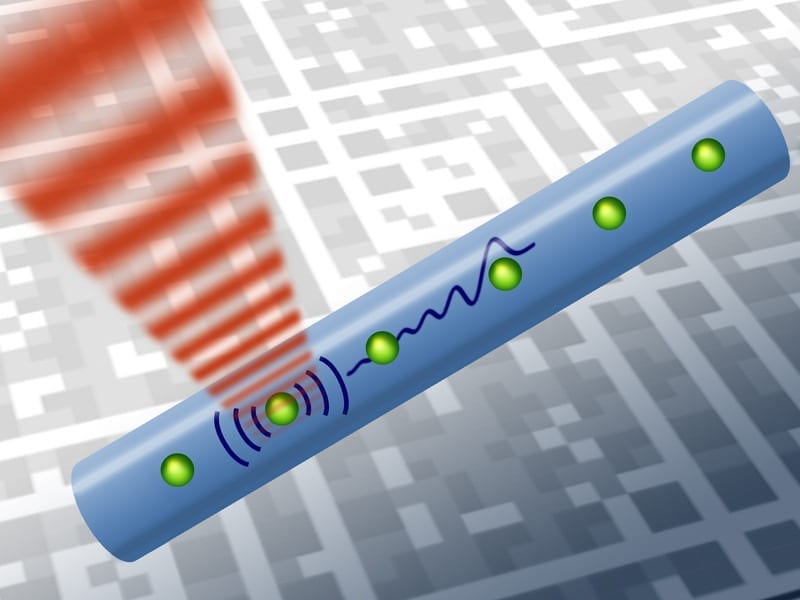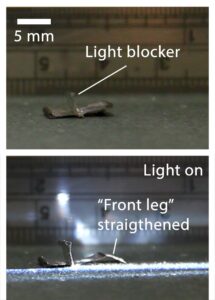
To develop micro- and biomimetic-robots, artificial muscles and medical devices, actuating materials that can reversibly change their volume under various stimuli are researched in the past thirty years to replace traditional bulky and heavy actuators including motors and pneumatic actuators.
A mechanical engineering team led by Professor Alfonso Ngan Hing-wan, Chair Professor in Materials Science and Engineering, and Kingboard Professor in Materials Engineering, Faculty of Engineering, the University of Hong Kong (HKU) published an article in Science Robotics on 30 May 2018 (EST) that introduces a novel actuating material – nickel hydroxide-oxyhydroxide – that can be powered by visible (Vis) light, electricity, and other stimuli. The material actuation can be instantaneously triggered by Vis light to produce a fast deformation and exert a force equivalent to 3000 times of its own weight. The material cost of a typical actuator is as low as HKD 4 per cm2 and can be easily fabricated within three hours.
Among various stimuli, light-induced actuating materials are highly desirable because they enable wireless operation of robots. However, very few light driven materials are available in the past, and their material and production costs are high, which hinder their development in actual applications such as artificial muscles for robotics and human assist device, and minimally invasive surgical and diagnostic tools.
Developing actuating materials was identified as the top of the 10 challenges in “The grand challenges of Science Robotics”1. Research in actuating materials can radically change the concept of robots which are now mainly motor-driven. Therefore, materials that can be actuated by wireless stimuli including a change in temperature, humidity, magnetic fields and light is one of the main research focus in recent years. In particular, a material that can be actuated by Vis light and produces strong, quick and stable actuation has never been achieved. The novel actuating material system – nickel hydroxide-oxyhydroxide that can be actuated by Vis light at relatively low intensity to produce high stress and speed comparable to mammalian skeletal muscles has been developed in this research initiated by engineers in HKU.
In addition to its Vis light actuation properties, this novel material system can also be actuated by electricity, enabling it to be integrated into the present well-developed robotics technology. It is also responsive to heat and humidity changes so that they might potentially be applied in autonomous machines that harness the tiny energy change in the environment. Because the major component is nickel, the material cost is low. The fabrication only involves electrodeposition which is a simple process, and the time required for the fabrication is around three hours, therefore the material can be easily scaled up and manufactured in industry.
The newly invented nickel hydroxide-oxyhydroxide responses to light almost instantaneously and produces a force corresponding to about 3000 times of its own weight (Figure 1).
1 Yang, Guang-Zhong, et al. “The grand challenges of Science Robotics.” Science Robotics 3.14 (2018): eaar7650.
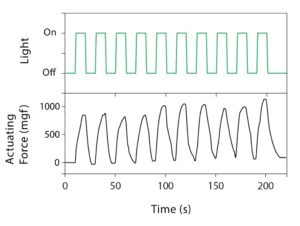
When integrated into a well-designed structure, a “mini arm” made by two hinges of actuating materials can easily lift an object 50 times of its weight (Figure 2). Similarly, by utilizing a light blocker, a mini walking-bot in which only the “front leg” bent and straighten alternatively and therefore moves under illumination was made so that it can walk towards the light source (Figure 3). These demonstrate that future applications in micro-robotics including rescue robots are possible.
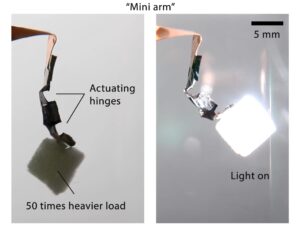
The evidences above revealed that this nickel hydroxide-oxyhydroxide actuating material can have different applications in the future, including rescue robots or other mini-robots. The intrinsic actuating properties of the materials obtained from our research show that by scaling up the fabrication, artificial muscles comparable to that of mammalian skeletal muscles can be achieved, and applying it in robotics, human assist device and medical devices are possible.
From a scientific point of view, this nickel hydroxide-oxyhydroxide actuating material is the world’s first material system that can be actuated directly by Vis light and electricity without any additional fabrication procedures. This also opens up a new research field on light-induced actuating behaviour for this material type (hydroxide-oxyhydroxides) because it has never been reported before.
The Latest on: Actuating materials
[google_news title=”” keyword=”actuating materials” num_posts=”10″ blurb_length=”0″ show_thumb=”left”]
via Google News
The Latest on: Actuating materials
- 10 Top Materials Stocks Of May 2024on May 2, 2024 at 5:11 am
Commissions do not affect our editors' opinions or evaluations. Materials like metal, concrete and chemicals are the foundation of the global economy—every sector requires basic materials ...
- XGIMI Halo+ review: a portable projection powerhouseon May 2, 2024 at 3:03 am
XGIMI has also included a decent remote with the Halo+ as well, with Google smart speaker support, along with directional control, settings, source support, and more impressively a switch that allows ...
- 12 types of roofing materials: Guide to choosing the best ones for youon April 28, 2024 at 5:00 pm
The type of roofing material you select can have a big impact on your home’s appearance, energy efficiency and ability to withstand the elements. In general, asphalt shingles make up the ...
- Here’s Why a Closed Loop Is Key for an EV Futureon April 22, 2024 at 10:48 am
Redwood Materials expands its battery recycling operations in the US, all aimed at recovering useful metals and materials from scrapped EVs. The company's operations produce 70% less CO2 emissions ...
- Engineering interactionson April 9, 2024 at 1:37 pm
By controlling these parameters, Finkelmann is able to tune the properties of the material to target a number of applications, which include actuating devices for robotics. There remains ...
- Lofree Flow Mechanical Keyboard review: Low-key impressiveon April 1, 2024 at 5:11 am
As such, I’m adept at spotting when a good one comes along — and able to fairly judge so, beyond the “Keys go click-clack” satisfaction of a solid actuating thock. The Lofree Flow is one ...
- Meet our expert academics in Engineering and Materials Scienceon March 21, 2024 at 11:24 pm
His research expertise includes developing smart soft materials that can sense their environment, and soft actuating materials that can change shape in response to a physical stimulus. He is a ...
- Lesson 1.2 - Testing Materials to Learn About Their Propertieson February 8, 2024 at 3:15 pm
Students will develop an understanding that objects and materials can be tested to learn about their properties. Students will help plan and conduct different tests on the materials. Students will be ...
- Bioinspired Structures and Designon November 4, 2023 at 9:39 pm
Zou, Linhua and Li, Xiaodong 2021. In Situ Observation of Fracture Behavior of Bamboo Culm. JOM, Vol. 73, Issue. 6, p. 1705. Liu, Yue and Fang, Liang 2022 ...
via Bing News







